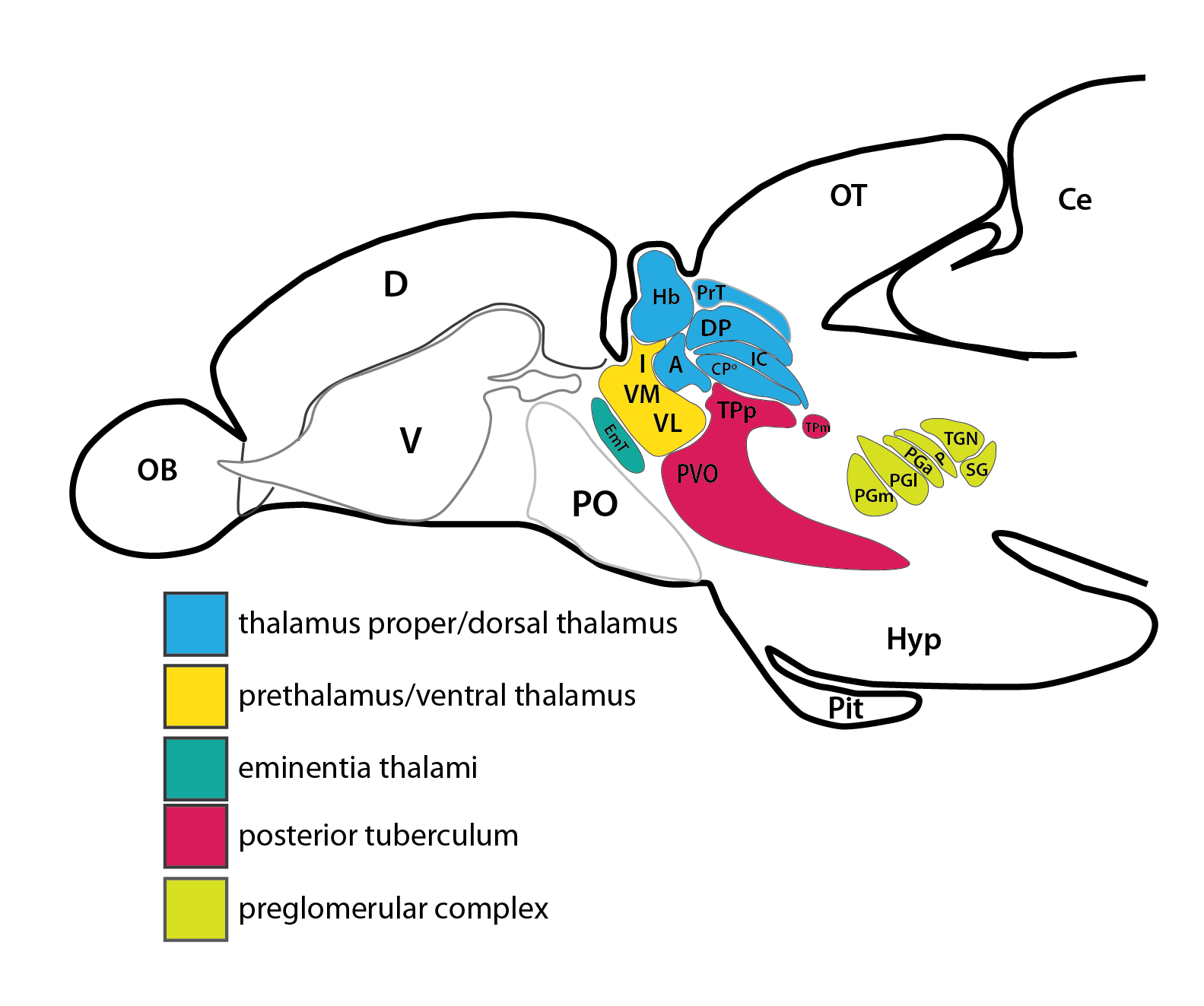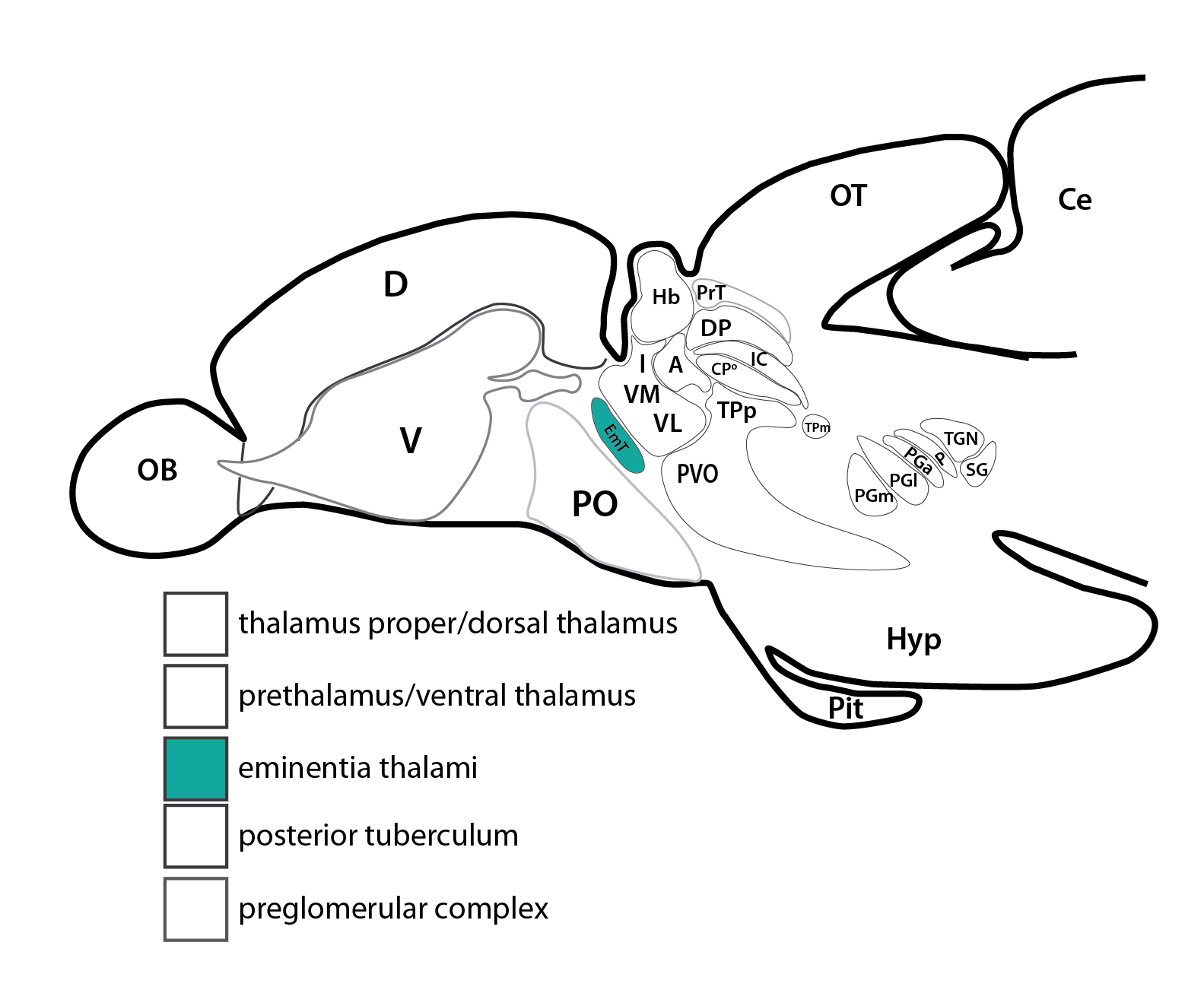Forebrain > Diencephalon> Eminentia Thalami
Schematic showing the position of the thalamic eminence in sagittal, horizontal and coronal sections through the zebrafish brain.
Based on the anatomical segmentation of 3 day old zebrafish larval brain by Thomas Müller, Olaf Ronneberger, Wolfgang Driever and colleagues. For details see Ronneberger et al., Nat. Meth. 2012 and http://vibez.informatik.uni-freiburg.de
Abbreviations: Ce, cerebellar plate; D, dorsal telencephalon/pallium; E, epiphysis; EmT, eminentia thalami; Hb, habenula; Hyp, hypothalamus; MO, medulla oblongata; OB, olfactory bulb; OT, optic tectum; PG, preglomerular complex; PO, preoptic area;PrT, pretectum; PTd, posterior tuberculum dorsal part; PTh, prethalamus; PTv posterior tuberculum ventral part; Teg, tegmentum; Th, thalamus; TS, torus semicircularis; V, ventral telencephalon/subpallium; Va, valvula cerebelli.
Description
The thalamic eminence is part of the diencephalon and lies ventral to the ventral thalamus and dorsal to the preoptic area. This region gives rise to the ventral entopeduncular nucleus that extends into the telencephalon and straddles the diencephalic/telencephalic border. The ventral entopeduncular nucleus is a major afferent nucleus to the habenulae.


Schematic adapted from Mueller 2012 showing the nuclei that comprise the wider thalamus.
Abbreviations: A, anterior thalamic nucleus; CPo, centroposterior thalamic nucleus; D, dorsal telencephalon (pallium); DP, dorsoposterior thalamic nucleus; EmT, eminentia thalami; Hyp, hypothalamus; Hb, habenula; I, intermediate thalamic nucleus; IC, intercalated thalamic nucleus; OB, olfactory bulb; OT, optic tectum; P, posterior thalamic (preglomerular) nucleus; PG, preglomerular complex; PGa, anterior preglomerular nucleus; PGc, caudal preglomerular nucleus; PGl, lateral preglomerular nucleus; PGm, medial preglomerular nucleus; PO, preoptic region; PrT, pretectum; PVO, paraventricular organ; SG, subglomerular nucleus; TGN, tertiary gustatory nucleus; TPp, periventricular nucleus of posterior tuberculum; TPm, migrated nucleus of posterior tuberculum; V,ventral telencephalon (subpallium); VL, ventrolateral thalamic nucleus; VM, ventromedial thalamic nucleus.
Ontology
is part of: forebrain
has parts:
OLS Tree Diagram
Anatomical segmentation of 3 day old zebrafish larval brain by Thomas Müller, Olaf Ronneberger, Wolfgang Driever and colleagues. For details see Ronneberger et al., Nat. Meth. 2012 and http://vibez.informatik.uni-freiburg.de
Transgenic Lines that label this brain region
Antibodies that label this brain region
Key Publications
Turner KJ., et al.
Afferent Connectivity of the Zebrafish Habenulae.
Front Neural Circuits. 2016 Apr 26;10:30. doi: 10.3389/fncir.2016.00030
Wullimann, M.F. & Mueller, T., 2004a.
Identification and morphogenesis of the eminentia thalami in the zebrafish.
Journal of Comparative Neurology, 471(1), pp.37–48.
Mueller, T., 2012.
What is the thalamus in zebrafish?
Frontiers in Neuroscience,6. pp.1–14.
Mueller T, Guo S.
The distribution of GAD67-mRNA in the adult zebrafish (teleost) forebrain reveals a prosomeric pattern and suggests previously unidentified homologies to tetrapods.
The Journal of comparative neurology. 2009;516(6):553-568. doi:10.1002/cne.22122.
Back to Forebrain






